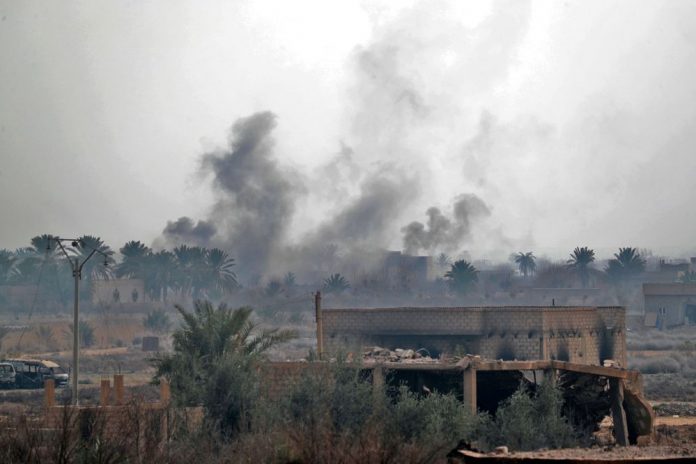In announcing his plan to withdraw American forces from Syria, President Donald Trump said the U.S. had achieved its purpose there because it had “defeated” Islamic State, the most destructive Islamist militant organization the world has seen. Certainly the group has been subdued in Iraq and Syria by an array of forces, including the U.S. military. But Islamic State has not been finished off. Remnants continue to fight in Iraq and Syria and prepare for a resurgence, while affiliated groups make mayhem around the world, especially in Africa.
1. What condition is Islamic State in?
Its self-declared caliphate — a state that claims dominion over all Muslims — is in ruins. The group has been pushed by U.S.-assisted Kurdish forces, Russian-backed Syrian troops and Iranian-supported militias to an ever-smaller area along the Iraq-Syria border. Its last remaining urban stronghold, Hajin in northeast Syria, fell in December. Still, it’s thought that the group’s enigmatic leader, Abu Bakr al-Baghdadi, as well as several top deputies are alive and that order within the organization remains intact.
2. What’s the group up to in Iraq and Syria?
Islamic State has turned to insurgency tactics such as bombings, sniper attacks and targeted killings. These are the same measures it used, in an earlier incarnation, to undermine faith in government and foment divisions following the 2003 U.S.-led invasion of Iraq. The group mounted 1,271 assaults and 148 assassinations of local leaders in northern Iraq in the first 10 months of 2018, according to Michael Knights, a senior fellow at the Washington Institute for Near East Policy. It claimed responsibility for a suicide bombing in the Syrian town of Manjib on Jan. 16 that killed 19 people including four Americans. The group’s tactics indicate it has no intention of giving up on Iraq and Syria and sees an opportunity to regain territory if the governments there fail to unite communities and rebuild.
3. How many Islamic State fighters are left there?
It’s hard to say. Estimates of the group’s strength have varied widely over the years. At the end of 2018, estimates ranged from several thousand to 30,000 fighters. What is certain is that some fighters who’d volunteered from abroad returned to their homelands in Europe and across the Middle East and North Africa, while many others were killed or fled to the desert, in line with the organization’s shift toward hit-and-run attacks. Replenishing the ranks from abroad would be difficult. An August 2018 report of the United Nations secretary-general concluded that the flow of foreign fighters to Iraq and Syria had essentially stopped as many countries have taken steps to make it harder for would-be jihadists to cross international frontiers.
4. What’s happened to Islamic State’s finances?
Islamic State’s average monthly revenue was about $80 million in 2015, according to IHS Markit, a London-based information and analytics organization. In losing nearly all the territory it controlled, the group also lost its major sources of income: oil assets, notably the fields of Deir Ezzor in Syria, and the ability to generate large sums through taxation and looting. Since it shifted from a proto-state to an underground network, the group has been better able to shield its funding flows from detection. Still, authorities monitoring Islamic State say it has infiltrated legitimate businesses such as construction, money exchange and fisheries; that it has invested laundered funds; and that it’s still able to channel money across borders.
5. What’s happened to its capacity for terrorist attacks?
Even without holding territory, Islamic State will probably have enough money in its war chest to support an insurgency in Iraq and Syria as well as sporadic terrorist attacks abroad for years, a report by the RAND Corporation concluded. Islamic State also continues to animate strikes by so-called lone-wolf terrorists, who are inspired by but have no formal ties to terrorist groups. The organization’s propaganda machine no longer functions at its peak level, but output has recovered somewhat from a slump in late 2017. Much of its media activity has moved to its affiliates. Efforts to counter its online influence are still a challenge, especially given its use of encrypted messaging apps.
6. How would a U.S. pullout affect the situation?
The 2,000 U.S. troops deployed in northeast Syria account for about a quarter of the ground forces in the country representing the U.S.-led, 74-nation coalition to combat Islamic State. Some analysts say the U.S. presence is symbolically important given that America’s military might is seen as unrivaled by many in the region. That said, airstrikes have made up the coalition’s main military activity, and they’d presumably continue after a U.S. withdrawal. The U.K.’s Maj. Gen. Christopher Ghika, a deputy commander of coalition forces, said after the U.S. pullout was announced that Islamic State “presents a very real threat to the long-term stability in this region and our mission remains the same, (its) enduring defeat.” A U.S. departure could precipitate a scramble for northeastern Syria among the U.S.-allied Syrian Kurdish forces who now control it; Turkey, which considers the Kurds a threat; and the Syrian regime, which is eager to regain the territory. Jihadist groups such as Islamic State often thrive in such chaos.
7. How worrisome are Islamic State’s affiliates and allies?
Groups around the world associated with Islamic State include some that were established directly as franchises, some that existed previously and have rebranded themselves as affiliates, others that operate separately but have sworn allegiance to Islamic State and still others that just share its goals.
To contact the reporter on this story: Caroline Alexander in London at calexander1@bloomberg.net
To contact the editors responsible for this story: Alaa Shahine at asalha@bloomberg.net, Mark Williams, Lisa Beyer






























